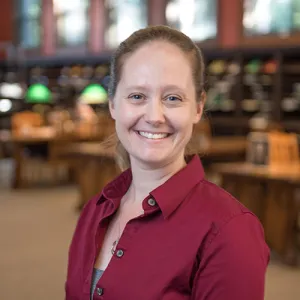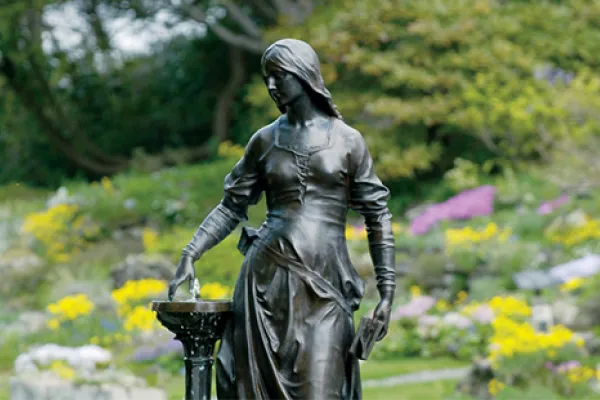Building a World Together in the Classroom
Faculty
The 2024 Sherrerd Teaching Prize winners share insights about teaching and learning
Published October 16, 2024
Patience, grace, and the power of bringing one’s whole self into the classroom are all lessons the recipients of this year’s teaching awards say they have learned from their students.
The 2024 recipients of the Kathleen Compton Sherrerd ’54 and John J. F. Sherrerd Prize for Distinguished Teaching are:
- Jennifer Beichman, senior lecturer in mathematical sciences
- Alicia Grubb, assistant professor of computer science
- Jina Kim, assistant professor of English language and literature and of the study of women and gender
The annual award was created to recognize excellent teaching by long-time Smith faculty members, as well as encourage newer faculty members who have demonstrated outstanding teaching and mentoring.
The college community is invited to celebrate this year’s honorees at a ceremony on Thursday, Oct. 24, at 4:30 p.m. in the Campus Center Carroll Room. Student and faculty nominators will introduce the award recipients, and a reception will follow in the atrium.
We asked the three prize winners to share some thoughts about what inspires and challenges them about teaching at Smith. Here’s what they had to say.
How do you describe the mission of your classroom to your students?

Jennifer Beichman: “It’s always important to me that students feel supported and able to be productively uncomfortable. I teach math! Most of the time when I tell people that, the response is ‘I always hated math’ or ‘math is scary.’ Students often come into my classes with bad experiences that color their ability to learn, so I always make it clear that while the learning process could be uncomfortable, they as people should not be uncomfortable.”
Alicia Grubb: “My mission is for us to form a community of learners with each student contributing, because you do not truly understand a concept until you can teach it to someone else. On the first day of class, I prefer to show my class my mission, rather than just tell them. For example, on the first day of algorithms this semester, we completed an activity to review and learn sorting using the ‘Jigsaw’ active learning method. In a single class, students learned from and taught each other about sorting. We didn’t even get to the syllabus until day two or three.”
Jina Kim: “The mission of my classroom is first and foremost one of collaboration and interdependency. On the first day of my classes, we speak with intention about the kind of discussion space we want to build together, and we brainstorm strategies about how we can get there.”
What’s changed the most about teaching since you first joined the profession?

Grubb: “One of the biggest changes I’ve noticed is an increased reliance on technology by all, and an increase in the number of devices my students bring to class. This was exacerbated by the pandemic when we all went remote. In my first year of teaching, roughly half the class carried a computer to lectures. Now, half the classes come with three devices: a phone, a laptop, and a tablet.”
Kim: “The challenges of COVID lockdown and the escalating right-wing attacks on academic freedom have had the most impact on my teaching life. Also, given the number of collective traumas we have endured in past years, student needs in the classroom have rapidly changed, requiring me to be more attentive, flexible, and creative in my teaching. If anything, recent changes in the higher education landscape have allowed me to further develop my feminist disability teaching ethos, and to articulate why this approach is so necessary today.”
What’s something that hasn’t changed about teaching?

Kim: “The joy I get from sharing a poem, thought or idea that my students find deeply moving.”
Beichman: “How much I still value working with college-age students. The four-ish years of a college education are hugely transformative for students. Some students come in and you can clearly see the kind of person they will become, and still others change and grow so much that they are almost unrecognizable. I still find great joy in being even a fleeting part of students’ growth and development into a further version of themselves.”
What led you to become an educator, and is this the career you expected to have?
Beichman: “I started teaching when I was working on my Ph.D. in mathematics. My program put a heavy emphasis on training graduate students to teach, and I got my own class of 28 students my first semester as a grad student. In some sense, I’ve been teaching calculus ever since. I knew from that first semester that being in front of a classroom was going to be an integral part of my career. What I didn’t anticipate was the ways in which teaching would also inform my love of advising students.”
Grubb: “Growing up, the most prominent career in my family was elementary school teacher. While I never really thought about becoming a teacher, when I was young I helped my mom get her kindergarten classroom ready each fall and every family party was full of discussions of lesson plans, learning goals, and assessments. I always loved solving puzzles as a kid and studied software engineering as an undergraduate. Toward the end of my Ph.D., as I was looking for jobs in the industry, my supervisor pitched the idea of applying for faculty positions at liberal arts colleges. I took her advice and applied. Now, I’m carrying on a family tradition—just in an unexpected place.”
Kim: “My hope was to spend as much time with art and literature as possible, whether I was making or experiencing it. Then I discovered feminist, critical race, and disability studies, all of which saved my life by showing me other ways to imagine and inhabit the world. Higher education seemed like a way I could share my life’s passions and my life rafts with others.”
What’s a lesson you have learned from your Smith students that keeps you inspired about teaching?
Kim: “I’ve learned so much from my students! They have taught me a lot about letting go. Letting go of my need to endlessly prepare for every situation, or of my need to figure out the direction of all conversations ahead of time. Because of them, I have learned to trust others to help carry the weight of conversation, and to build an intellectual world together. Because without collective effort, there is no intellectual world to inhabit.”
Grubb: “My students have taught me the power of authenticity and bringing one’s whole self into the classroom. When I started, I felt that I should ‘look and act like a professor’—maintain a facade of excellence and near-perfection. Over the years, and especially through the pandemic, my students brought their own authenticity and vulnerability to the classroom at a level I had never seen before. They taught me that if I expected them to take chances and make mistakes, then I needed to model and value that behavior. Students shared that they appreciated the quirky things that made me unique. The less I tried to be ‘the professor,’ the more I was able to relax and connect with my students.”
Beichman: “I’ve learned the value of patience, grace, and laughter. It’s hard to express how much a little bit of patience on my part can make a huge difference for a student; how a little bit of grace can humanize them and me; or how sometimes, just laughing about nonsense can change a day from mediocre to outstanding. Teaching can require giving hugely of yourself, but I find that students give back what they get and you, as a teacher, reap the benefits.”
